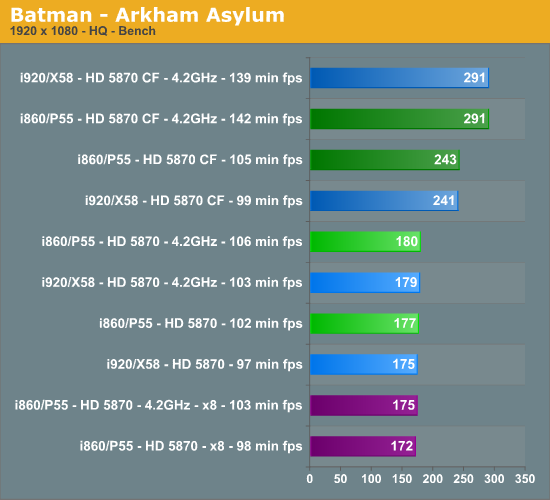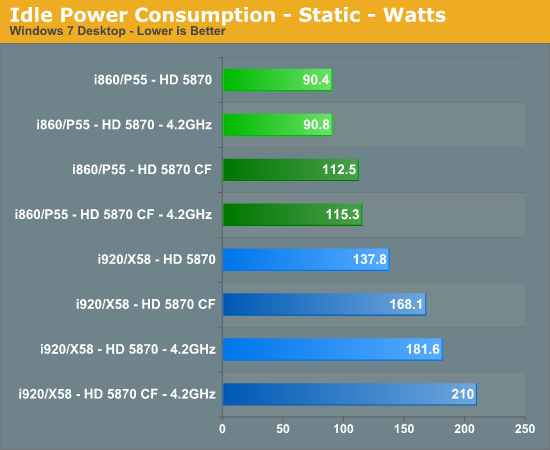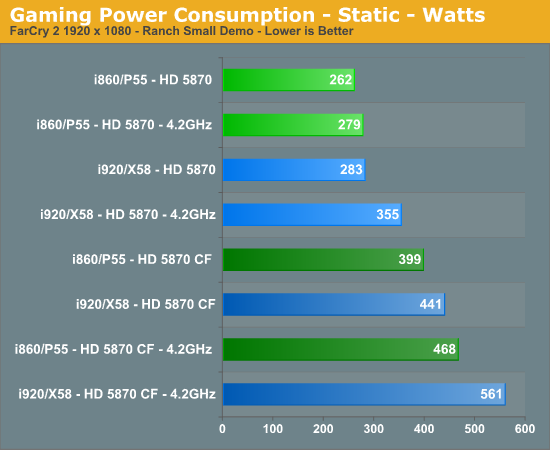ATI HD 5870 Scaling Performance: X58 vs P55 Showdown
by Gary Key on September 29, 2009 12:00 PM EST- Posted in
- Motherboards
One of our favorite new games is Batman - Arkham Asylum. We set all options as high as they will go and utilize the games built-in benchmark for our results. Both platforms are just stupid fast when running this game.

The single card results at x8 trails the x16 results by about 1% at stock and 3% when overclocked. Minimum frame rates for the x16 single card results are around 5% better on the P55 platform at stock and 3% when overclocked.
Batman – Arkham Asylum CrossFire Scaling – Average Frame Rates
| ATI HD 5870 CF Scaling | Batman – Arkham Asylum | Batman – Arkham Asylum 4.2GHz |
| Intel Core i7 920 (X58) | 37.7% | 62.6% |
| Intel Core i7 860 (P55) | 37.3% | 61.7% |
At stock and overclocked speeds, both platforms are practically tied when it comes to scaling in average frame rates.
Batman – Arkham Asylum CrossFire Scaling – Minimum Frame Rates
| ATI HD 5870 CF Scaling | Batman – Arkham Asylum | Batman – Arkham Asylum 4.2GHz |
| Intel Core i7 920 (X58) | 2.1% | 34.9% |
| Intel Core i7 860 (P55) | 7.1% | 33.9% |
Minimum frame rates favor the P55 by 6% and scaling favors the P55 by 5% in our stock results, while the X58 is slightly ahead in the overclocking test.
Power Consumption
Both systems have all power management features enabled and we utilize the Balanced Power option in Windows 7. Our 4.2GHz overclock setting has the Core i7 860 VCore offset option enabled with an ending voltage of 1.3875V. VTT is set to 1.310V, CPU PLL at 1.80V, and VDimm at 1.62V. The Core i7 920 offset is enabled for a final VCore reading of 1.335V. VTT is set to 1.375V, CPU PLL at 1.86V, and VDimm at 1.65V.

Idle power is Lynnfield's biggest ally and the Radeon HD 5870 plays well here. Even overclocked to 4.2GHz with a pair of 5870s, Lynnfield uses less power than a single 5870 on an i7 920. Bloomfield runs at a 12x multiplier at idle while Lynnfield runs at 9x. Bloomfield also likes to ramp up VTT voltage in a hurry compared to Lynnfield, the result is nearly zero impact at idle power consumption but when Bloomfield is overclocked, the platform just consumes more power thanks to additional circuitry.

Under load, once again, there's virtually no impact from CPU overclocking on Lynnfield compared to Bloomfield. At stock frequencies however, the GPU power dominates and thus there's less than a 10% power difference between X58 and P55.










85 Comments
View All Comments
TurdMiner - Wednesday, September 30, 2009 - link
TA152H "Wow, I'm being patronized by someone with half my IQ. And not even well. That's actually the worst attitude. That patronizing attitude like you're superior...How hypocritical."That's hella funny.
You meant that to be funny, right?
tim851 - Wednesday, September 30, 2009 - link
I don't think he gets it.TimboG - Tuesday, September 29, 2009 - link
I agree with you that they should NEVER alter ANY processor or motherboard speed settings during a platform performance comparison benchmark.How in the world can you publish a "comparison" between two platforms when the chipsets themselves have been altered from their stock setting? This is nuts.
I read but keep quiet on most everything AnandTech publishes but this one takes the cake. To call itself a comparison of platforms where each has been altered is one article headed for file 13. I have noticed several of the "professional" review websites doing this in the past year or so and I for one think this type of comparison should be discontinued altogether. If you want to test overclocking ability then do it in a separate article. If you want to compare overclocked performance between multiple platforms then do it as such. Not as a direct performance comparison between platforms where each has been altered.
You guys with your little plaques hanging on your walls and the cute name tags on your shirts are driving me mad while trying to get straight answers to simple questions.
How about some real-time direct comparisons to what has been produced instead of what you want to "play" with in the BIOS before you benchmark? I don't care if TURBO is on if it is part of the "normal" operation of the combined CPU/motherbaord combo. At least that way it will show what you can expect "out of the box".
Intel has continually been degrading our options as this last development cycle has progressed with less CPU options per platform and slowly removing functionality from others.
It's almost like going to an auto dealer and getting the "confusion sell" tactic push onto us.
I could go on forever. No USB3, no SATA6 ? At least there should have been some news during IDF to present new chipsets that supported these features, but nothing. It's almost laughable, but sad actually.
Then we get manipulated platforms portrayed as being compared directly against each other and the results are something we should use to make a purchase decision with? Then combine that with the confusion sell Intel is already pushing on us. This is NUTS!
goinginstyle - Tuesday, September 29, 2009 - link
"I agree with you that they should NEVER alter ANY processor or motherboard speed settings during a platform performance comparison benchmark."Dude, nothing was altered as they kept the systems at stock values/settings and ensured the memory timings were the same between platforms. How fair can you get and by the way they were open about everything. It is a sad state of affairs when being honest in an article gets you slammed.
Jumpem - Tuesday, September 29, 2009 - link
In the original P55 review, and follow up i7 860 review, the i7 860 delivered higher framerates than the i7 920 at stock speeds.In this write up the i7 920 is coming out on top at stock speeds. I'm slightly confused. Gary, do you care to comment?
Gary Key - Tuesday, September 29, 2009 - link
We were using the NVIDIA (275/285) cards in those reviews. ;) I have a meeting with AMD in the morning to further discuss our results. They have been working with our test results since this weekend to pinpoint why the HD 5870 is generating different results than the NV cards and even the HD 4890.turnipoid - Tuesday, September 29, 2009 - link
I really don't see the point of this article if it doesn't include 2560 X 1600.xrror - Wednesday, September 30, 2009 - link
Probably because if you can afford a 2560x1600 monitor you already have an x58 in preparation for i9.the zorro - Wednesday, September 30, 2009 - link
at that resolutions the lynnfield bottleneck becomes more evident.so it's better not to include that resolution.
the zorro - Tuesday, September 29, 2009 - link
wow, Battle Forge CrossFire Scaling – Minimum Frame Rates difference is huge.this show how crippled the lynnfield platform is.
almost 100% percent difference between lynnfield and x58
this sucks.
what's wrong with intel?